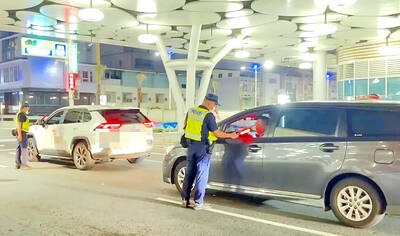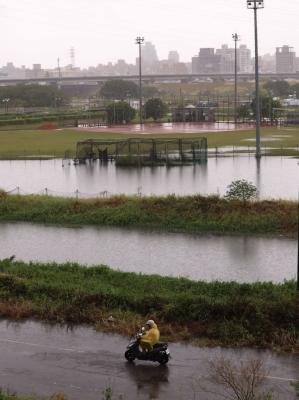The Environmental Protection Administration (EPA) has designated all cities and counties except Taitung as class-three air pollution control zones — the most severe level of pollution according to the agency’s three-class system — due to increased particulate matter (PM) pollution.
The EPA made a low-key announcement about the pollution zone designation on its Web site on Wednesday — a move that an environmental group criticized as being too late and ineffective given a lack of preventive measures.
The increase was due to the inclusion of particulate matter measuring less than 2.5 micrometers (PM2.5) as a factor for the identification of air pollution control zones. All cities and counties except Taitung had PM2.5 levels that exceeded the legal limit of 15 micrograms per cubic meter.
The EPA included PM2.5 as an air pollution index in 2012, and the Wednesday announcement was made after factoring in PM2.5 monitoring data from 2012 to last year.
The designation raised the number of municipalities recognized as class-three air pollution control zones dramatically from seven last year to 21.
Last year, only six municipalities with heavy industrial pollution in central and southern Taiwan, and Kinmen County were designated class-three zones.
The announcement marked the first time Yilan, Hualien and Penghu have been designated class-three pollution control zones.
The designation is to take effect next year, with stricter environmental regulations being imposed on class-three zones to reduce factory and traffic emissions, the EPA said, adding that local governments have to propose pollution reduction plans.
Taiwan Healthy Air Action Alliance convener Yeh Guang-peng (葉光芃) yesterday criticized the EPA for being slow in taking action to reduce pollution.
The agency could have made the designation earlier, so more effective pollution prevention measures could have ben implemented, he said.
The EPA could have made the designation at the end of last year when it was apparent that the three-year averages of PM2.5 levels in most cities exceeded the limit, Yeh said.
The delay means there will be no new pollution prevention measures until the designation takes effect next year, Yeh said, questioning the EPA’s willingness to fight pollution.
“EPA Minister Lee Ying-yuan’s (李應元) pledge [to reduce air pollution] was an empty slogan, because I have not seen the agency propose any useful measures to reduce air pollution except to say it is allocating more budget for pollution prevention,” he said.
In June, Lee said the agency would invest NT$30 billion (US$946 million) in air pollution prevention and aims to reduce “red level” air pollution incidents by half in four years.
According to the EPA’s four-color categorization of PM2.5, “red” is the second-most severe level, corresponding to PM2.5 levels of 59 to 64 micrograms per cubic meter.
“Pollution reduction is not a student paper competition. One cannot reduce pollution with pretty slogans,” Yeh said.
“In an anti-air pollution demonstration [in December last year], we asked the government to establish a special task force to reduce pollution. However, we have not seen the new administration take any action,” he added.

TRAFFIC SAFETY RULES: A positive result in a drug test would result in a two-year license suspension for the driver and vehicle, and a fine of up to NT$180,000 The Ministry of Transportation and Communications is to authorize police to conduct roadside saliva tests by the end of the year to deter people from driving while under the influence of narcotics, it said yesterday. The ministry last month unveiled a draft of amended regulations governing traffic safety rules and penalties, which included provisions empowering police to conduct mandatory saliva tests on drivers. While currently rules authorize police to use oral fluid testing kits for signs of drug use, they do not establish penalties for noncompliance or operating procedures for officers to follow, the ministry said. The proposed changes to the regulations require

The Executive Yuan yesterday announced that registration for a one-time universal NT$10,000 cash handout to help people in Taiwan survive US tariffs and inflation would start on Nov. 5, with payouts available as early as Nov. 12. Who is eligible for the handout? Registered Taiwanese nationals are eligible, including those born in Taiwan before April 30 next year with a birth certificate. Non-registered nationals with residence permits, foreign permanent residents and foreign spouses of Taiwanese citizens with residence permits also qualify for the handouts. For people who meet the eligibility requirements, but passed away between yesterday and April 30 next year, surviving family members

Taipei, New Taipei City, Keelung and Taoyuan would issue a decision at 8pm on whether to cancel work and school tomorrow due to forecasted heavy rain, Keelung Mayor Hsieh Kuo-liang (謝國樑) said today. Hsieh told reporters that absent some pressing reason, the four northern cities would announce the decision jointly at 8pm. Keelung is expected to receive between 300mm and 490mm of rain in the period from 2pm today through 2pm tomorrow, Central Weather Administration data showed. Keelung City Government regulations stipulate that school and work can be canceled if rain totals in mountainous or low-elevation areas are forecast to exceed 350mm in

China Airlines Ltd (CAL) yesterday morning joined SkyTeam’s Aviation Challenge for the fourth time, operating a demonstration flight for “net zero carbon emissions” from Taiwan Taoyuan International Airport to Bangkok. The flight used sustainable aviation fuel (SAF) at a ratio of up to 40 percent, the highest proportion CAL has achieved to date, the nation’s largest carrier said. Since April, SAF has become available to Taiwanese international carriers at Taipei International Airport (Songshan airport), Kaohsiung International Airport and Taoyuan airport. In previous challenges, CAL operated “net zero carbon emission flights” to Singapore and Japan. At a ceremony at Taoyuan airport, China Airlines chief sustainability